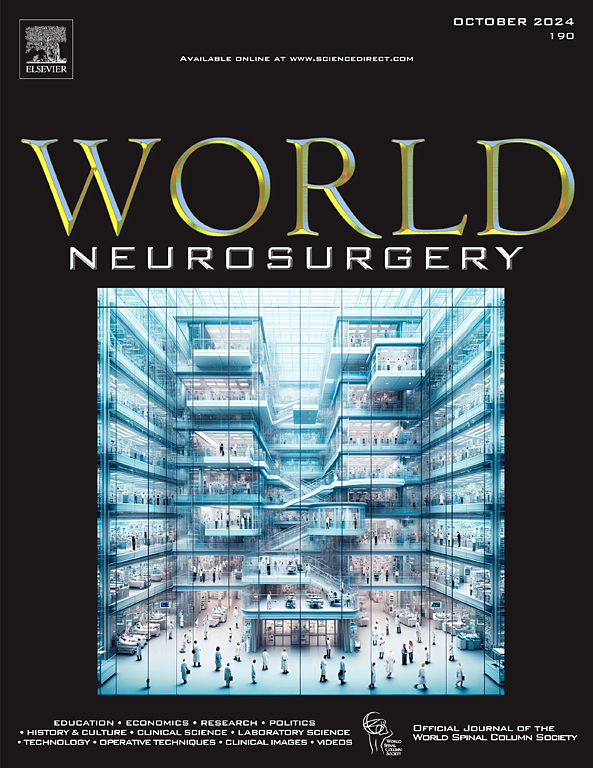Curative Treatment of Brain Arteriovenous Malformations Combining Endovascular and Surgical Approaches Consecutively
IF 1.9
4区 医学
Q3 CLINICAL NEUROLOGY
引用次数: 0
Abstract
Background
Brain arteriovenous malformations (AVMs) pose a significant treatment challenge, with options including microsurgical resection, endovascular embolization, radiosurgery, or combinations thereof. We present our experience with a curative strategy combining complete endovascular treatment followed by microsurgical resection under the same anesthesia session, without relying on a hybrid operating room.
Methods
We reviewed consecutive patients with AVM who underwent endovascular treatment and microsurgical resection in a single anesthesia session (COMBI-AVM protocol) from December 2017 to July 2022. Primary endpoints were angiographic AVM obliteration status and modified Rankin Scale score at last follow-up. AVMs were graded by the Spetzler-Martin (SM) system, comparing low-grade (SM I, SM II, SM III with nidus <3 cm) and high-grade (SM III with nidus ≥3 cm, SM IV, SM V) AVMs.
Results
Of 46 patients with AVM, 34 had low-grade (73.9%) and 12 had high-grade (26.1%) AVMs. The protocol feasibility was 100%. Median anesthesia time was 8.7 hours (interquartile range, 7.6–10.6). Complete AVM removal was achieved in 45 patients (97.8%), with no recurrences at late (>6 months) follow-up in any of the 32 patients (71.1%) with available follow-up data. Good clinical outcomes (modified Rankin Scale score ≤2) were seen in 91.3% of patients. Disabling treatment-related complications occurred in 4 patients (8.6%), including 1 death (2.2%).
Conclusions
Combining maximal endovascular embolization and complete surgical resection in a single session in patients with AVM yielded a high cure rate and low morbidity, especially for low-grade lesions. This technique may make it possible to treat high-grade AVMs previously considered ineligible for surgery and reduce periprocedural morbidity.
血管内联合手术连续治疗脑动静脉畸形。
脑动静脉畸形(AVMs)的治疗面临着巨大的挑战,目前的治疗方案包括显微手术切除、血管内栓塞、放射手术或其联合治疗。在这里,我们介绍了我们的治疗策略,在相同的麻醉时间下,结合完全血管内治疗和显微手术切除,而不依赖于混合手术室。方法:我们回顾了2017年12月至2022年7月连续接受血管内治疗(EVT)和单次麻醉(COMBI-AVM方案)显微手术切除(MS)的AVM患者。主要终点为最后随访时血管造影AVM闭塞状态和改良Rankin量表(mRS)评分。采用Spetzler-Martin (SM)评分系统对AVM进行分级,比较低级别(SM- i、SM- ii、SM- iii)与病灶。结果:46例AVM患者中,34例为低级别(73.9%)AVM, 12例为高级别(26.1%)AVM。方案的可行性为100%。中位麻醉时间8.7 h (7.6 ~ 10.6 IQR)。45例患者(97.8%)完全切除了AVM, 32例患者(71.1%)在随访后期(6 ~ 6个月)均无复发。91.3%的患者临床预后良好(mRS≤2)。4例患者(8.6%)出现致残治疗相关并发症,包括1例死亡(2.2%)。结论:血管内最大栓塞联合手术切除一次手术治疗AVM,治愈率高,发病率低,特别是对低级别病变。这项技术可以治疗以前认为不适合手术的高级别动静脉畸形,并减少术中发病率。
本文章由计算机程序翻译,如有差异,请以英文原文为准。
求助全文
约1分钟内获得全文
求助全文
来源期刊

World neurosurgery
CLINICAL NEUROLOGY-SURGERY
CiteScore
3.90
自引率
15.00%
发文量
1765
审稿时长
47 days
期刊介绍:
World Neurosurgery has an open access mirror journal World Neurosurgery: X, sharing the same aims and scope, editorial team, submission system and rigorous peer review.
The journal''s mission is to:
-To provide a first-class international forum and a 2-way conduit for dialogue that is relevant to neurosurgeons and providers who care for neurosurgery patients. The categories of the exchanged information include clinical and basic science, as well as global information that provide social, political, educational, economic, cultural or societal insights and knowledge that are of significance and relevance to worldwide neurosurgery patient care.
-To act as a primary intellectual catalyst for the stimulation of creativity, the creation of new knowledge, and the enhancement of quality neurosurgical care worldwide.
-To provide a forum for communication that enriches the lives of all neurosurgeons and their colleagues; and, in so doing, enriches the lives of their patients.
Topics to be addressed in World Neurosurgery include: EDUCATION, ECONOMICS, RESEARCH, POLITICS, HISTORY, CULTURE, CLINICAL SCIENCE, LABORATORY SCIENCE, TECHNOLOGY, OPERATIVE TECHNIQUES, CLINICAL IMAGES, VIDEOS
 求助内容:
求助内容: 应助结果提醒方式:
应助结果提醒方式:


